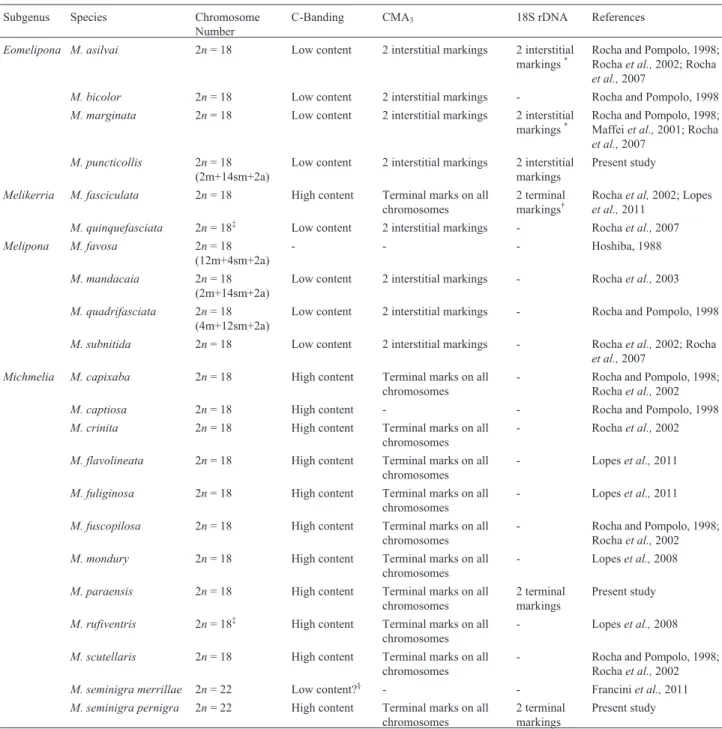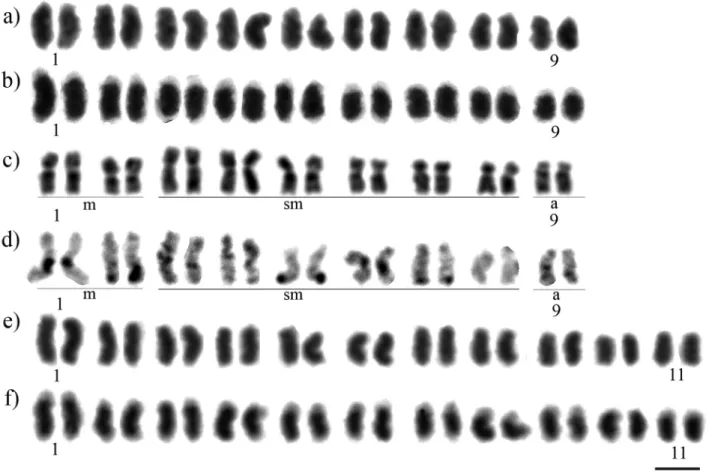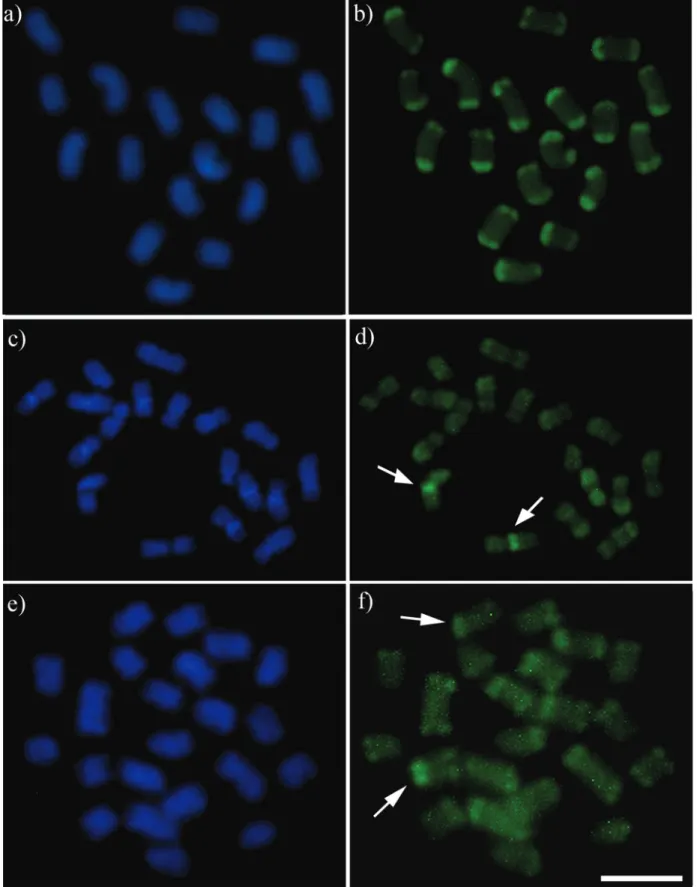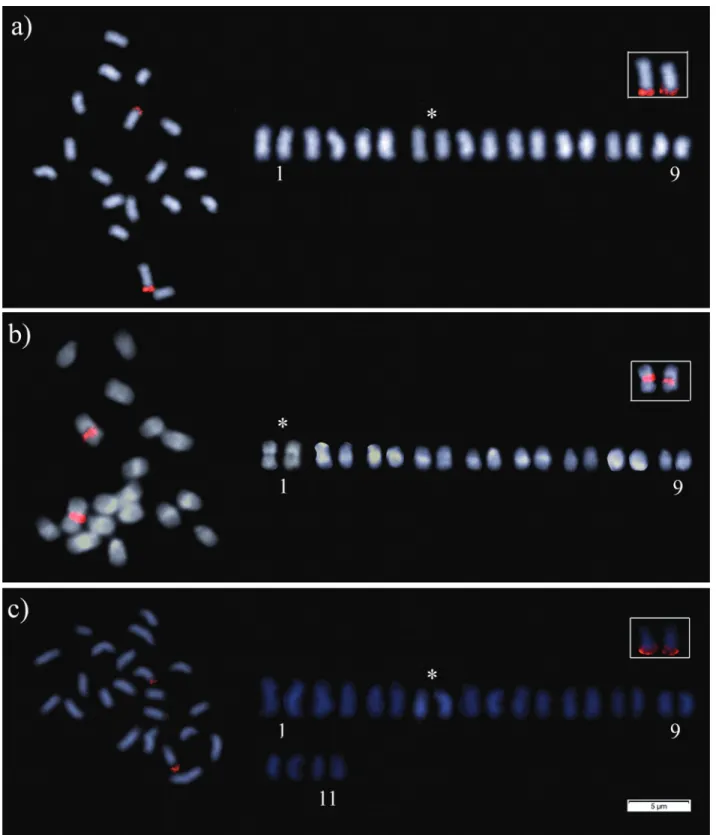Comparative cytogenetics in three
Melipona
species (Hymenoptera: Apidae)
with two divergent heterochromatic patterns
Marina Souza da Cunha
1, Natália Martins Travenzoli
1, Riudo de Paiva Ferreira
1,2, Edson Kuatelela
Cassinela
1,3, Henrique Barbosa da Silva
1, Francisco Plácido Magalhães Oliveira
4, Tânia Maria Fernandes
Salomão
1and Denilce Meneses Lopes
11
Laboratório de Biologia Molecular de Insetos, Departamento de Biologia Geral, Universidade Federal de
Viçosa, Viçosa, MG, Brazil.
2Faculdade de Ciências Gerenciais de Manhuaçu, Campus Alfa Sul, Manhuaçu, MG, Brazil.
3Camargo Cancer Center, Centro Internacional de Ensino e Pesquisa (CIPE), São Paulo, SP, Brazil.
4Instituto de Medicina Veterinária, Universidade Federal do Pará, Campus de Castanhal, Castanhal, PA,
Brazil.
Abstract
The genusMelipona is subdivided into four subgenera based on morphological characteristics, and two groups based on cytogenetic patterns. The cytogenetic information on this genus is still scarce, therefore, the goal of this study was to characterizeMelipona paraensis, Melipona puncticollis, and Melipona seminigra pernigra using the fol-lowing techniques: C-banding, DAPI/CMA3fluorochromes, and FISH with an 18S rDNA probe.Melipona paraensis
(2n=18) and M. seminigra pernigra (2n=22) were classified as high heterochromatin content species (Group II). Their euchromatin is restricted to the ends of the chromosomes and is CMA3
+
; the 18S rDNA probe marked chromosome pair number 4.Melipona puncticollis (2n=18) is a low heterochromatin content species (Group I) with chromosome pair number 1 marked with CMA3and 18S rDNA. Low heterochromatin content is a putative ancestral karyotype in
this genus and high content is not a monophyletic trait (Melikerria presents species with both patterns). Differences concerning the karyotypic characteristics can be observed amongMelipona species, revealing cytogenetic rear-rangements that occurred during the evolution of this genus. Studies in other species will allow us to better under-stand the processes that shaped the chromatin evolution inMelipona.
Keywords: Chromosomal evolution, DAPI/CMA3 fluorochromes, Fluorescent in situ Hybridization (FISH), heterochromatin,
Meliponini.
Received: October 26, 2017; Accepted: February 23, 2018.
Introduction
Species belonging to the Meliponini tribe are also known as stingless bees. These highly eusocial bees are of pantropical distribution and are important both economi-cally and ecologieconomi-cally. They produce honey and propolis, pollinate a variety of cultivated and native crops, and play an important role as providers of ecosystem services (Kerr
et al., 1996; Heard, 1999; Cortopassi-Laurinoet al., 2006; Michener, 2007). In the Neotropics, Meliponini is com-posed of 33 genera with approximately 417 valid species (Camargo and Pedro, 2013). Among these genera,
MeliponaIlliger 1806 is the most species-rich genus in this tribe (Silveiraet al., 2002), represented by 73 described
species of which 43 occur in Brazil, and it is subdivided into four subgenera based on morphological characteris-tics:Eomelipona, Melipona stricto sensu,Michmelia,and
Melikerria(Camargo and Pedro, 2013). It is important to highlight that a revision is needed, sinceEomeliponais the only subgenus that was not recovered as a monophyletic clade in a molecular phylogenetic analysis (Ramírezet al., 2010; Rasmussen and Cameron, 2010).
Cytogenetic studies on 22Meliponaspecies indicate a preserved autosome diploid number of2n= 18 chromo-somes in most of the species studied so far, withMelipona seminigra merillaeCockerell, 1919 being the exception, showing 2n= 22 chromosomes (reviewed in Tavareset al., 2017). Despite the conservatism in the diploid number, the
Meliponaspecies have a divergent pattern regarding hete-rochromatin content, and defined through C-banding tech-nique it can be subdivided into two groups: Group I is comprised of species with a low content of
heterochro-Send correspondence to Denilce M. Lopes. Departamento de Bio-logia Geral, Universidade Federal de Viçosa, Av. P. H. Rolfs, s/n, Centro, Viçosa, 36570-900, MG, Brazil. E-mail: denilce.lopes@ufv.br.
matin, while Group II is comprised of species with a high heterochromatin content (Rocha and Pompolo, 1998; Rochaet al., 2002, 2003; Lopeset al., 2008, 2011). In this context, the subgenera Eomelipona andMelipona stricto sensuare comprised only of species with a low content of heterochromatin, Michmelia only of species with a high content, whileMelikerriahas species with both patterns. The cytogenetic data available on the genusMelipona
re-garding chromosome number, C-banding, CMA3, and 18S
rDNA patterns is revised in Table 1.
The goal of this study was to describe the cytogenetic characteristics (chromosomal number, heterochromatin content, DAPI/CMA3fluorochromes, and 18S rDNA
pat-terns) of three Melipona species (Melipona paraensis
Ducke, 1916, Melipona puncticollis Friese, 1902, and
Melipona seminigra pernigraFriese, 1903), and to compile
Table 1- Cytogenetic data available on 22Meliponaspecies regarding their chromosome number (karyotypic formula), C-banding (high or low content), CMA3and 18S rDNA patterns. Species were assigned to subgenera based on the Moure’s catalogue.
Subgenus Species Chromosome
Number
C-Banding CMA3 18S rDNA References
Eomelipona M. asilvai 2n= 18 Low content 2 interstitial markings 2 interstitial markings*
Rocha and Pompolo, 1998; Rochaet al.,2002; Rocha
et al.,2007
M. bicolor 2n= 18 Low content 2 interstitial markings - Rocha and Pompolo, 1998
M. marginata 2n= 18 Low content 2 interstitial markings 2 interstitial markings*
Rocha and Pompolo, 1998; Maffeiet al.,2001; Rocha
et al.,2007
M. puncticollis 2n= 18 (2m+14sm+2a)
Low content 2 interstitial markings 2 interstitial markings
Present study
Melikerria M. fasciculata 2n= 18 High content Terminal marks on all chromosomes
2 terminal markings†
Rochaet al,2002; Lopes
et al.,2011
M. quinquefasciata 2n= 18‡ Low content 2 interstitial markings - Rochaet al.,2007
Melipona M. favosa 2n= 18 (12m+4sm+2a)
- - - Hoshiba, 1988
M. mandacaia 2n= 18 (2m+14sm+2a)
Low content 2 interstitial markings - Rochaet al.,2003
M. quadrifasciata 2n= 18 (4m+12sm+2a)
Low content 2 interstitial markings - Rocha and Pompolo, 1998
M. subnitida 2n= 18 Low content 2 interstitial markings - Rochaet al.,2002; Rocha
et al.,2007
Michmelia M. capixaba 2n= 18 High content Terminal marks on all chromosomes
- Rocha and Pompolo, 1998;
Rochaet al.,2002
M. captiosa 2n= 18 High content - - Rocha and Pompolo, 1998
M. crinita 2n= 18 High content Terminal marks on all chromosomes
- Rochaet al.,2002
M. flavolineata 2n= 18 High content Terminal marks on all chromosomes
- Lopeset al.,2011
M. fuliginosa 2n= 18 High content Terminal marks on all chromosomes
- Lopeset al.,2011
M. fuscopilosa 2n= 18 High content Terminal marks on all chromosomes
- Rocha and Pompolo, 1998;
Rochaet al.,2002
M. mondury 2n= 18 High content Terminal marks on all chromosomes
- Lopeset al.,2008
M. paraensis 2n= 18 High content Terminal marks on all chromosomes
2 terminal markings
Present study
M. rufiventris 2n= 18‡ High content Terminal marks on all chromosomes
- Lopeset al.,2008
M. scutellaris 2n= 18 High content Terminal marks on all chromosomes
- Rocha and Pompolo, 1998;
Rochaet al.,2002
M. seminigra merrillae 2n= 22 Low content?§ - - Franciniet al.,2011
M. seminigra pernigra 2n= 22 High content Terminal marks on all chromosomes
2 terminal markings
Present study
*Ag-NOR data.
†
M. compressipesin the paper of Rochaet al.(2002) is indeedM. fasciculata(Tavareset al., 2017). ‡B chromosomes were reported in these two species.
§
the cytogenetic data available for this taxon in order to identify the chromosomal variation that is characteristic for eachMeliponaGroup (I and II), as well as to understand the role of these regions in the evolution of chromosomes in the genus.
Material and Methods
The three Melipona species (M. paraensis, M. puncticollis,andM. seminigra pernigra) were collected in Altamira, state of Pará, Brazil. The specimens were identi-fied by Sílvia Regina de Menezes Pedro (Universidade de São Paulo, Ribeirão Preto, Brazil), and deposited in the sci-entific collection of the Apiário Central at Universidade Federal de Viçosa, Viçosa, Minas Gerais, Brazil. Mitotic chromosomes were obtained from cerebral ganglia of lar-vae in the final defecation stage (Imaiet al., 1988). The conventional staining was done using Giemsa diluted in Sorensen buffer in a 1:30 proportion, and at least 25 larvae of each species were analyzed. The chromosomes were classified following the arm ratios given by Levanet al.
(1964). Heterochromatin was visualized through C-ban-ding (Sumner, 1972) and digital images of the metaphases were taken in a BX53F Olympus microscope equipped
with a DP73F Olympus camera, using CellSens imaging software.
Sequential staining with the fluorochromes 4’-6-dia-mindino-2-phenylindole (DAPI) and chromomycin A3
(CMA3) was performed following the method of Schweizer
(1980). Fluorescentin situHybridization (FISH) followed the protocol described by Pinkelet al.(1986) using a ribo-somal 18S rDNA probe isolated fromM. monduryobtained through Polymerase Chain Reaction (PCR) using the fol-lowing primers: 5’-TAATTCCAGCTCCAATAG-3’ and 5’-CCACCCATAGAATCAAGA-3’. This probe was la-beled by an indirect method using digoxigenin-11-dUTP (Roche Applied Science), and the signal was detected with anti-digoxigenin-rhodamine (Roche Applied Science). Digital images of the fluorescence images were captured in a BX53F Olympus microscope equipped with an MX10 Olympus camera using CellSens imaging software. An av-erage of 10 metaphases was analyzed to determine the cytogenetic patterns revealed by the different techniques used in this study.
Results
The diploid chromosome number of M. paraensis
was defined as 2n= 18 (Figure 1a). C-banding revealed that
Figure 1- Karyotypes ofMelipona paraensis(a - Giemsa-stained, b - C-banding);Melipona puncticollis(c - Giemsa-stained, d - C-banding); and
the major part of each chromosome is comprised of hetero-chromatin. This hindered the visualization of centromeres, and hence it was not possible to define the karyotypic for-mula (Figure 1b). The DAPI/CMA3analysis indicated that
the heterochromatin is DAPI+(Figure 2a and Figure S1a-c), while CMA3+ marked all the extremities of the
chromo-somes corresponding to the euchromatin region (Figure 2b). FISH with 18S rDNA probe marked chromosome pair number 4 in its terminal position (Figure 3a).
The diploid chromosome number ofM. puncticollis
was defined as 2n= 18 and its karyotypic formula as 2n= 2m + 14sm + 2a (Figure 1c). C-banding indicated a low content of heterochromatin that is restricted to the peri-centromeric region of chromosome pair numbers 1, 3, 6, 9, and the subtelomeric region of the long arms of chromo-some pair numbers 2, 4, 5 and 7, while chromochromo-some pair number 8 is completely euchromatic (Figure 1d). Sequen-tial staining with DAPI/CMA3 fluorochromes indicated
strong DAPI+bands corresponding to the heterochromatin region (Figure 2c), while CMA3marked the interstitial
re-gion of chromosome pair number 1 (Figure 2d). The same result was found with the 18S rDNA FISH probe (Figure 3b).
The diploid chromosome number of M. seminigra pernigrawas defined as 2n= 22 (Figure 1e). C-banding re-vealed that the majority of each chromosome is composed of heterochromatin, hindering the visualization of the cen-tromeres, so it was not possible to define the karyotypic for-mula (Figure 1f). DAPI/CMA3analysis indicated that the
heterochromatin is DAPI+ (Figure 2e and Figure S1d-f). CMA3+marked all the extremities of the chromosomes
cor-responding to the euchromatin region, and we could iden-tify one chromosome pair that strongly stained with CMA3
fluorochrome (Figure 2f). FISH with the 18S rDNA probe marked chromosome pair number 4 in its terminal position (Figure 3c).
Discussion
The three species analyzed in this study presented dis-tinct chromosome numbers:M.(Michmelia)paraensisand
M.(Eomelipona)puncticollispresented 2n = 18 chromo-somes, whileM. (Michmelia) seminigra pernigrashowed 2n= 22 chromosomes. The autosomal chromosome num-ber that prevails in the genusMeliponais 2n= 18, but a few exceptions can be found, such as in M. (Michmelia) seminigra merillaethat also has 2n = 22, and Melipona (Melikerria) quinquefasciata Lepeletier, 1836 and
Melipona (Michmelia) rufiventrisLepeletier, 1836, both of which have 2n= 18 autosomal chromosomes, but they pres-ent variation with respect to the number of B chromosomes found in different populations (reviewed in Tavareset al., 2017).
Regardless of the conservatism in the diploid number, differences concerning the karyotypic formula and hetero-chromatin content could be observed among species,
re-vealing cytogenetic rearrangements that have occurred dur-ing the evolution of the genus. Changes in the karyotypic formula among species belonging to Group I indicate the occurrence of pericentric inversions that altered the number of metacentric and submetacentric chromosomes in this group:Melipona favosaFabricius, 1798 (2n= 12m + 4sm + 2a) (Hoshiba, 1988),Melipona mandacaiaSmith, 1863 (2n
= 2m + 14sm + 2a) (Rochaet al., 2003),M. puncticollis(2n
= 2m + 14sm + 2a) (present study), and Melipona quadrifasciataLepeletier, 1836 (2n = 4m + 12sm + 2a) (Silva et al., 2012). In Group II species, the high heterochromatin content masks the position of the centro-mere, and therefore, makes it difficult to identify the mor-phology of the chromosomes to define the karyotypic formula of these species. This is a common trait among the
Meliponaspecies belonging to Group II, rather than an is-sue related to the quality of the metaphases (Rochaet al., 2002; Lopeset al., 2008, 2011).
In the species analyzed in this study,M. puncticollis
is a low heterochromatin content species, while M. paraensisandM. seminigra pernigraare high heterochro-matin content species (Figure 1). The first description of the C-banding pattern onM. seminigra merrilaeindicated this subspecies as part of Group I, with low heterochromatin content (Franciniet al., 2011), but analyzing the images from that publication, the pattern seems to be very similar to the high heterochromatin content species, as it was not possible to visualize the centromeres, and they had hetero-chromatin as the predominant constituent of the chromo-somes. Ongoing cytogenetic studies on this subspecies confirm that M. seminigra merrillae, as well as M. seminigra pernigraare high heterochromatin content sub-species belonging to Group II (unpublished data).
In eusocial bees, the heterochromatin is usually AT-rich (DAPI+) (Brito et al., 2003; Rochaet al., 2003; Lopeset al., 2011; Godoyet al., 2013), and this is a pattern shared byMeliponaspecies with both low and high hetero-chromatin content (Figure 2). CMA3+ positive bands are
another characteristic used to distinguish Groups I and II in this genus (Table 1): Group I species have only one chro-mosome pair CMA3+marked in its interstitial position, and
this chromosome pair is usually related to the nucleolar or-ganizing region (NOR) (Rochaet al., 2002), indicating that the NOR is CG-rich in this group; Group II species have CMA3+terminal markings on all of the chromosomes
cor-responding to the euchromatin, indicating that these re-gions are CG-rich, and in some cases it is possible to identify one pair with the brightest mark as associated with ribosomal cistrons, as for instance in M. seminigra pernigra(Figure 2F) and other high heterochromatic con-tent species (Lopeset al., 2008, 2011). It is interesting to note that the solitary beeMelitoma segmentariaFabricius, 1804 has the opposite pattern, as the euchromatic portion of the chromosomes are CMA3-and the heterochromatic ones
such asEuglossa townsendiCockerell, 1904 andEuglossa carolinaLinnaeus, 1758), have the same cytogenetic
diver-gence asMeliponawith regard to the heterochromatin con-tent (species with low and high heterochromatin concon-tent),
but they have unique CMA3accumulation patterns,
show-ing that the heterochromatin is heterogeneous with respect to its composition, with some blocks rich in AT and others rich in CG (Fernandeset al., 2013), highlighting the diver-sity of the patterns observed among bees.
To this date, there is only one report that has used FISH to confirm the position of the NORs with an 18S rDNA FISH probe; this was done inMelipona fasciculata
Smith, 1854 (Rochaet al., 2002, revised in Tavareset al., 2017). Together with our study, it seems that only one pair
Figure 3- Fluorescentin situhybridization (FISH) pattern with 18S rDNA probe: metaphase cells and arranged karyotype of (a)Melipona paraensis; (b)
of chromosomes labeled with this probe, which can be con-sidered as a conserved characteristic in this genus (Figure 3). Studies applying ribosomal probes in bees are still scarce, but analyses combining Ag-NOR, CMA3+ bands,
and FISH 18S rDNA techniques have been used to identify NORs in different Meliponini species (Rochaet al., 2002; Britoet al., 2005; Duarteet al., 2009; Krinskiet al., 2010; Lopes et al., 2011; Godoy et al., 2013; Miranda et al., 2013). Based on these three different techniques it can be inferred that having only one pair of NORs is a conserved characteristic inMelipona(Table 1).
Regardless of the conservatism in the number of mar-kings, the position of the 18S rDNA cistrons can be used to differentiate Groups I and II inMelipona, as they are inter-stitial in low content species and terminal in high content ones (Table 1). Independent of the technique applied, the literature indicates pair number 1 as the NOR bearer in this genus. For:Melipona asilvaiMoure, 1971,M. mandacaia,
andMelipona marginataMoure, 1992 this was inferred by Ag-NOR (Maffeiet al., 2001; Rochaet al., 2002, 2003). ForMelipona bicolorLepeletier, 1836,Melipona capixaba
Moure and Camargo, 1994, Melipona mondury Smith, 1863, M. quadrifasciata, M. quinquefasciata, M. rufiventris,andMelipona subnitidaDucke, 1910 the identi-fication was done by CMA3fluorochrome (Rocha et al.,
2007; Lopeset al., 2008), and for M. fasciculata it was identified by FISH with a ribosomal probe (Rochaet al., 2002 revised in Tavareset al., 2017). However, in our study only the low content speciesM. puncticollishad the first pair as the NOR bearer, while the high content speciesM. paraensisand M. seminigra pernigrahad pair number 4 marked with the 18S rDNA probe (Figure 3), highlighting another distinct characteristic between Groups I and II. We argue that none of the cited studies above arranged the karyotype. Hence in metaphase cells, the terminal location of the probe in the high content species might have given the impression of a bigger chromosome (see Figure 3).
Despite being polyphyletic, basal Eomelipona spe-cies group together withMelipona stricto sensu(Ramírez
et al., 2010), and this clade is composed of species with low heterochromatin content (Table 1), indicating that this is the plesiomorphic characteristic of the genus, while high heterochromatin content appeared more than once during the evolution and diversification of this taxon, emerging in bothMelikerriaandMichmeliasubgenera. As we could ob-serve both heterochromatin patterns inMelikerria(Table 1), the classification of theMeliponaspecies into low and high heterochromatin content species did not form natural groups and did not represent monophyletic clades in the phylogenetic analysis.
The current study aimed to describe threeMelipona
species with divergent patterns of heterochromatin accu-mulation, arguing that a karyotype with low heterochro-matin content is a putative ancestral karyotype in this genus and that high heterochromatin content is not a
monophy-letic characteristic. We also contributed with new cytoge-netic data on Groups I and II, highlighting the cytogecytoge-netic rearrangements that occurred during the chromosome evo-lution in this major stingless bee genus. Finally, we empha-size the importance of cytogenetic analyses to evidence the chromosomal rearrangements that occurred during the evo-lution of different species (Imaiet al., 1994; Menezeset al., 2014). Studies in other species will allow us to better under-stand the processes that shaped chromatin evolution in
Melipona.
Acknowledgments
The authors wish to thank NORTE ENERGIA and BIOTA for logistical support during field work done in Altamira, state of Pará, Brazil. Financial support is ac-knowledged from Conselho Nacional de Desenvolvimento Científico e Tecnológico (CNPq), Coordenação de Aper-feiçoamento de Pessoal de Nível Superior (CAPES), Fun-dação de Amparo à Pesquisa do Estado de Minas Gerais (FAPEMIG), and Fundação Amazônia de Amparo a Estu-dos e Pesquisas do Pará (FAPESPA).
References
Brito RM, Caixeiro APA, Pompolo SG and Azevedo GG (2003) Cytogenetic data of Partamona peckolti (Hymenoptera, Apidae, Meliponini) by C banding and fluorochrome stain-ing with DA/ CMA3and DA/DAPI. Genet Mol Biol
26:53-57.
Brito RM, Pompolo SG, Magalhães MFM, Barros EG and Saka-moto-Hojo ET (2005) Cytogenetic characterization of two
Partamonaspecies (Hymenoptera, Apidae, Meliponini) by fluorochrome staining and localization of 18 S rDNA clus-ters by FISH. Cytologia 70:373-380.
Camargo JMF and Pedro SRM (2013) Meliponini Lepeletier, 1836. In: Moure JS, Urban D and Melo GAR (eds) Cata-logue of Bees (Hymenoptera, Apoidea) in the Neotropical Region. Sociedade Brasileira de Entomologia, Curitiba, pp. 272-578.
Cortopassi-Laurino M, Imperatriz-Fonseca VL, Roubik DW, Do-lin A, Heard T, Aguilar I, Venturieri GC, Eardley C and Nogueira-Neto P (2006) Global meliponiculture: Chal-lenges and opportunities. Apidologie 37:275-292.
Cristiano MP, Simoes TG, Lopes DM and Pompolo SG (2014) Cytogenetics of Melitoma segmentaria (Fabricius, 1804) (Hymenoptera, Apidae) reveals differences in the character-istics of heterochromatin in bees. Comp Cytogenet 8:223-231.
Duarte OMP, Martins CCC and Waldschmidt AM (2009) Occur-rence of multiple nucleolus organizer regions and intra-specific karyotype variation inScaptotrigona xanthotricha
Moure (Hymenoptera, Meliponini). Genet Mol Res 8:831-839.
Fernandes A, Werneck HA, Pompolo SG and Lopes DM (2013) Evidence of separate karyotype evolutionary pathway in
Euglossa orchid bees by cytogenetic analyses. An Acad Bras Cienc 85:937-944.
Melipona seminigra merrillae reveals different chromo-some number for the genus. Sci Agr 68:592-593.
Godoy DC, Ferreira RP and Lopes DM (2013) Chromosomal variation and cytogenetics ofPlebeia luciiandP. phrynos-toma(Hymenoptera: Apidae). Fla Entomol 96:1559-1566. Heard TA (1999) The role of stingless bees in crop pollination.
Annu Rev Entomol 44:183-206.
Hoshiba H (1988) Karyological analysis of a stingless bee, Meli-pona favosa (Apidae, Hymenoptera). Cytologia 53:153-156.
Imai HT, Taylor RW, Crosland MW and Crozier RH (1988) Modes of spontaneous chromosomal mutation and karyo-type evolution in ants with reference to the minimum inter-action hypothesis. Jpn J Genet 63:159-185.
Imai HT, Taylor RW and Crozier RH (1994) Experimental bases for the minimum interaction theory. I. Chromosome evolu-tion in ants of the Myrmecia pilosula species complex (Hymenoptera: Formicidae: Myrmeciinae). Jpn J Genet 69:137-182.
Kerr WE, Carvalho GA and Nascimento VA (1996) Abelha Uruçu - Biologia, Manejo e Conservação. Fundação Acan-gaú, Belo Horizonte, 157 p.
Krinski D, Fernandes A, Rocha MP and Pompolo SG (2010) Karyotypic description of the stingless beeOxytrigona cf.
flaveola (Hymenoptera, Apidae, Meliponina) of a colony from Tangará da Serra, Mato Grosso State, Brazil. Genet Mol Biol 33:494-498.
Levan A, Fredga K and Sandberg AA (1964) Nomenclature for centromeric position on chromosomes. Hereditas 52:201-220.
Lopes DM, Pompolo SG, Campos LAO and Tavares MG (2008) Cytogenetic characterization ofMelipona rufiventris Lepe-letier 1836 and Melipona mondury Smith 1863 (Hyme-noptera, Apidae) by C banding and fluorochromes staining. Genet Mol Biol 31:49-52.
Lopes DM, Fernandes A, Praça-Fontes MM, Werneck HDA, Resende HC and Campos LAO (2011) Cytogenetics of three
Melipona species (Hymenoptera, Apidae, Meliponini). Sociobiology 58:185-194.
Maffei EMD, Pompolo SG, Silva-Junior JC, Caixeiro APA, Ro-cha MP and Dergam JA (2001) Silver staining of nucleolar organizer regions (NORs) in some species of Hymenoptera (bees and parasitic wasps) and Coleoptera (lady beetle). Cytobios 104:119-125.
Menezes RST, Carvalho JPSO, Silva TS, Somovilla A and Costa MA (2014) Evolutionary trends in the chromosome numbers of swarm-founding social wasps. Insectes Soc 61:385-393. Michener CD (2007) The bees of the world. 2nd edition. The
Johns Hopkins University Press, Baltimore, 972 p. Miranda RV, Fernandes A and Lopes DM (2013) Karyotype
de-scription ofCephalotrigona femorataSmith (Hymenoptera:
Apidae) and the C-banding pattern as a specific marker for
Cephalotrigona. Sociobiology 60:125-127.
Pinkel D, Straume T and Gray JW (1986) Cytogenetic analysis us-ing quantitative, high sensitivity, fluorescence hybridiza-tion. Proc Natl Acad Sci U S A 83:2934-2938.
Ramírez SR, Nieh JC, Quental TB, Roubik DW, Imperatriz-Fonseca VL and Pierce NE (2010) A molecular phylogeny of the stingless bee genus Melipona (Hymenoptera: Apidae). Mol Phylogenet Evol 56:519-525.
Rasmussen C and Cameron SA (2010) Global stingless bee phy-logeny supports ancient divergence, vicariance, and long distance dispersal. Biol J Linn Soc 99:206-232.
Rocha MP and Pompolo SG (1998) Karyotypes and heterochro-matin variation (C-bands) inMeliponaspecies (Hymenop-tera, Apidae, Meliponinae).Genet Mol Biol 21:41-45. Rocha MP, Pompolo SG, Dergam JA, Fernandes A and Campos
LAO (2002) DNA characterization and karyotypic evolu-tion in the bee genusMelipona(Hymenoptera, Meliponini). Hereditas 136:19-27.
Rocha MP, Cruz MP, Fernandes A, Waldschmidt AM, Silva-Junior JC and Pompolo SG (2003) Longitudinal differentia-tion in Melipona mandacaia (Hymenoptera, Meliponini) chromosomes. Hereditas 138:133-137.
Rocha MP, Pompolo SG, Fernandes A and Campos LAO (2007)
Melipona: Six decade of cytogenetic. Biosci J 23:111-117. Schweizer D (1980) Simultaneous fluorescent staining of R bands
and specific heterochromatic regions (DA – DAPI bands) in human chromosomes. Cytogenet Cell Genet 27:190-193. Silva WRT, Araújo ED and Scher R (2012) Caracterização do
cariótipo de uma população de abelhas Melipona quadrifasciata (Hymenoptera: Meliponini), no município de Brejo Grande/SE. Scientia Plena 8:1-6.
Silveira FA, Melo GAR and Almeida EAB (2002) Abelhas Brasi-leiras: Sistemática e Identificação. Editora IDM Compo-sição e Arte, Belo Horizonte, 254 p.
Sumner AT (1972) A simple technique for demonstrating centro-meric heterochromatin. Exp Cell Res 75:304-306.
Tavares MG, Lopes DM and Campos LAO (2017) An overview of cytogenetics of the tribe Meliponini (Hymenoptera: Apidae). Genetica 3:241-258.
Supplementary material
The following online material is available for this article: Figure S1 – DAPI stained metaphases ofMelipona paraensis
Melipona seminigra pernigra.
Associate Editor: Yatio Yassuda-Yonenaga



